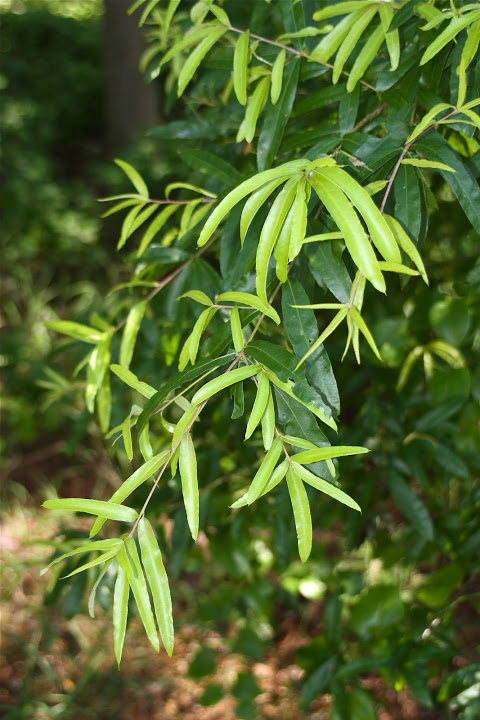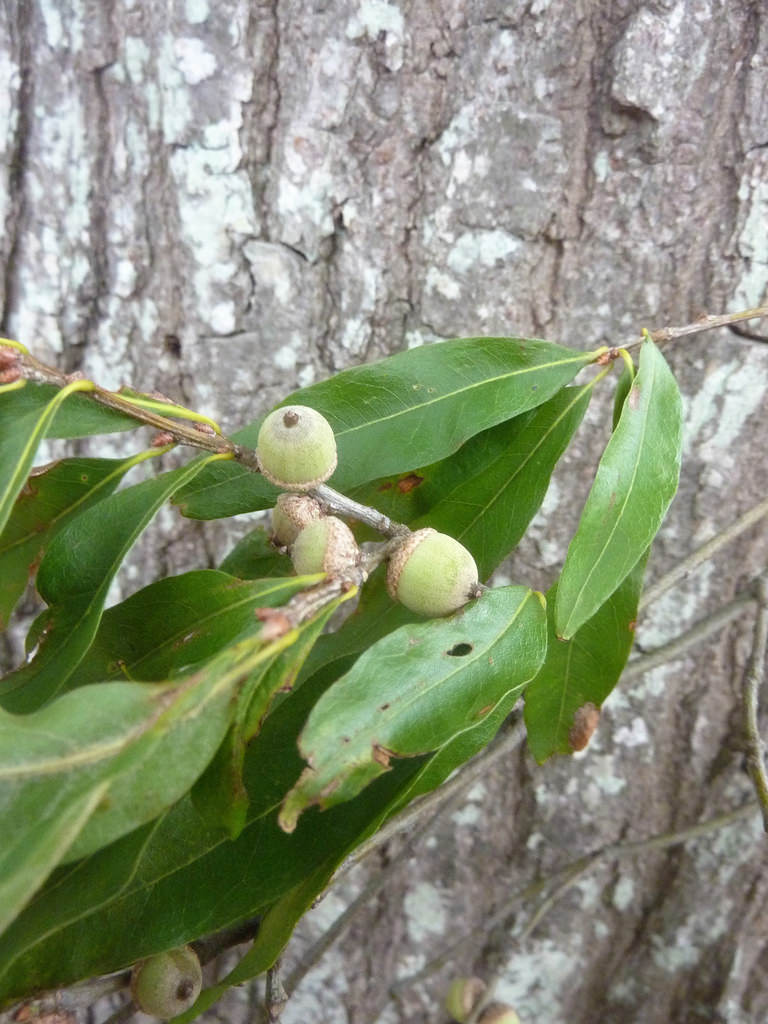Willow Oak
Quercus phellos L.
Description
Willow oak is a member of the beech family (Fagaceae). The trees at mature height are around 40 to 60 feet6 but may reach heights up to 120 feet³. Root growth is shallow and water requirements are high³. The leaves are elongated with no lobes with a single bristle at the end². These leaves are simple and have an alternate arrangement. Male and female unisexual flowers are produced at the same time during mid-spring5. Pollination is by wind5. Fertile female flowers develop into acorns. The tree must be is about 20 years old before acorns are produced5. These acorns are small, roughly 0.5 inches long with a thin cap covering the top6.

Leaves of willow oak. @ J. Brighton, 2012, Maryland Plant Atlas 4

Willow oak bark and acorns. @ Jane Hill, 2016. Maryland Plant Atlas4
Distribution
Willow oaks can be found in coastal plains along the eastern and southern coasts of the United States². They can reach as far north as New Jersey and as far west as eastern Texas². These trees can be found throughout the central and eastern regions of Maryland7. Willow oaks grow in areas that are commonly flooded or along streams3. It is rarer to find them upland3 . They require full to partial sun and thrive in areas with moist, acidic soils¹.

Native distribution of willow oak. USDA5
Wildlife Importance
Willow oaks produce a hefty acorn crop every year which provides a food source for many forms of wildlife, including whitetail deer, wild turkeys, squirrels and various songbirds such as blue jays³. When the land around it floods, the acorns are then carried off and eaten by ducks, mallards and others³. Willow oaks are also used for erosion control as they are planted along rivers and streams that flood. Their ability to absorb a lot of water from the soil makes them useful for soil restoration in very wet areas³.
Economic Importance
Willow oaks are one of the more common trees used in landscaping. They grow well in many different soil types and due to their shallow root system, they are easily transplanted³. Willow oaks are mostly used as shade trees in urban areas and parks. Willow oak wood is also used for pulp and paper production³.
Threats
Trunk borers, such as the red oak borer (Enaphalodes rufulus) pose a large threat to the willow oak². The tree is easily damaged by fires since the bark is very thin³. This makes the tree more susceptible to pathogens. Leaves develop necrotic blotches when exposed to acid rain³.
Interesting Facts
- Despite belonging to the red oak group, the willow oak lacks the characteristic lobed leaves that red oaks possess. Instead, the leaves are more “spear-shaped”6.
- There is no relation to willow plants (Salix sp.) from which the tree gets its name due to the shape of the leaves and the fact that some lateral branches droop down giving it a willow-like appearance5.
- The species epithet given to the willow oak, “phellos”, is the Greek word for an entirely different species of tree, the cork oak6.
- The largest willow oak in Maryland is in Kent County. It is 105 feet tall, 89.5 inches in diameter and has a crown spread of 119.5 feet when measured in 20107.
- The first scientific observation of the willow oak was in 17231.
References
- Arbor Day Foundation: Willow oak
- USDA, NRCS Plant Fact Sheet: Willow Oak
- USDA Forest Service Fire Effects Information System: Quercus phellos
- Maryland Plant Atlas: Quercus phellos
- USDA Forest Service Silvics Vol. 2 Hardwoods: Quercus phellos
- University of Kentucky College of Agriculture, Food and Environment: Willow oak
- Maryland Big Trees
Contributed by J. Geiger and P. Fitzgerald
